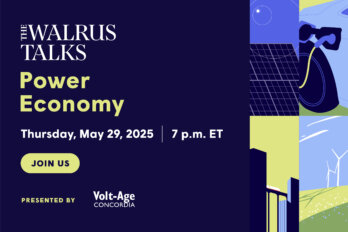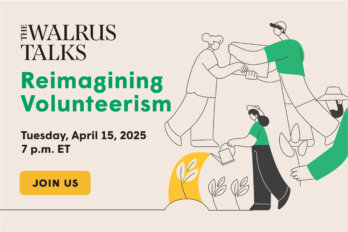Mahadeo Sukhai is the Head of Research and Chief Accessibility Officer at the Canadian National Institute for the Blind and he spoke at The Walrus Talks Inclusion in Waterloo on Oct. 23, 2019.
You can watch all The Walrus Talks speakers from this event here: The Walrus Talks Inclusion on YouTube
Hello, everyone I’m going to introduce myself. My name is Mahadeo Sukhai. I am the head of research and chief accessibility officer of the Canadian National Institute for the Blind or CNIB. I’m also the world’s first congenitally blind geneticist, and I love tea. Coffee puts me to sleep, but I love tea. It’s one of my two vices, books or the other of my two vices. Reading a good book, drinking a good cup of tea, sitting next to my wife. That’s pure bliss. Coffee shops are fun places to hang out, coffee shops and bookstores even better. So let me tell you about a few favorite coffee shops of mine. Coffee shop number one, wonderful place to be. Great environment, lots of teas. Great online menu. Nice to look at. Problem is not all teas are available all the time. Every time I go in I have to actually ask the staff what’s available.
Coffee shop number two. Also a great place to hang out. Lots of teas. They’ve got lots of different format menus. They’ve got the online menu. They’ve got the menu above the counter. They’ve got the menu in print, the menu in print is fantastic as long as you can see. I’ll ask the staff, “What teas do you have? What teas do you have?” They’ll actually give you the menu first. They will talk with me, but they’ll give me the menu first. Coffee shop number three, they let me behind the counter. I get to interact with the teas directly. That’s fun.
As a society, we’ve got an interesting challenge. We tend to have a serious difficulty separating the terms diversity, accessibility and inclusion. Diversity, a representational term ends up getting confused and thought to be synonymous with the other two. Almost to the point where we as a nation or as a community or as a business or as a team start to conflate them and we start to measure diversity when we really want to be measuring accessibility and inclusion. That’s a challenge. Accessibility and inclusion, there’s epic confusion between those two terms. I’ve given workshops to people. I’ve asked the question, what’s the difference? Here’s one of the classic answers I get. Accessibility is for persons with disabilities. Inclusion is for everybody else. Okay, let’s unpack that for a moment.
I live with sight loss. I was born blind. I’ve lived with sight loss all my life. All right, fine. I’m also a South Asian, Caribbean descended, first-generation Canadian immigrant, male, naturalized citizen, double income household, married and, and, and, and, and. I could go on, right? So you can’t expect me to and you and you shouldn’t expect me to actually separate those identities one from another. So let’s come back to the coffee shops for a moment. Coffee shop number one is diversity. Lots of teas. Coffee shop number two represents accessibility, multiple formats of the menu. Coffee shop number three represents inclusion. Because agency of choice is retained. I’m empowered to be able to fully participate in the tea purchasing process. I can go behind the counter without assistance and I can pick out the teas that I want.
All right, so now here’s an interesting thing about coffee shop number one. It also allows us to unpack the term accessibility and the term usability. Accessible menu. Read it on my iPhone. Not a very usable menu, is it, if something on that menu is not present in the store? As accessibility and inclusion professionals, we often get these two terms confused and we ourselves have to be really careful about that because when we put a process into place, when we design a product, when we put a service in the field, we have to make sure that it’s both accessible to everyone who’s going to use it as well as usable to everyone who’s going to use it.
The interesting thing about the world that we live in is everything’s on demand. Food’s on demand. Movies are on demand. You name it, it’s on demand. Internet’s on demand. Information is on demand. Thank you very much, Wikipedia. Here’s an interesting thing. We start to think accessibility is on demand and the problem with on demand is that we’re demand. It means we demand it, we ask for it. That’s one meeting. But the other meaning is it’s prepared for us when we need it, all right? The interesting thing is that when it comes to on demand and just in time thinking, we get accessibility and inclusion horribly confused. Take a step back. Personalized medicine in cancer, this used to be my field. I can talk about it.
We don’t do that without some level of testing, say genetic testing and when we test and we get a result, we don’t have this mad physician and nurse scramble to figure out which drug has to be given and then to go get it from the pharmacy. It’s already there. It’s already prepared. If you don’t like that example, let’s try a different one. Elevators. Elevators are fun. They’re great. Newer buildings especially have wonderful accessible elevators. They’re big, they’re spacious, they’ve got braille. The buttons have embossing on them. You can actually feel the letters and numbers. Go into a new elevator and try that one out. Unless some wag actually turned off the voice, it’ll talk to you. Wags turn off the voice all the time.
New elevators in new buildings, I can walk in there and I can very easily, very confidently without too much kerfuffle use the elevator. That’s proactive design thinking. Deployed as an environmental solution right there upfront. Now, 50 years ago, couldn’t do that. Needed help. That’s reactive thinking. I needed a person. You could probably argue with me and some of you might that having a person is an environmental solution. It’s a proactive design. Okay, fine, but what happens if that person has sight loss and what about my ability to go where I want when I want? Because you’ve taken that out of the equation. So proactive design gets us to universal design. Universal design, we can look at that as a set of solutions that empower the greatest number of people to participate in the activities in question in the most effective ways possible.
We often confuse that with getting the greatest number of people to participate for the minimal effort. That’s the 80-20 rule. The problem with the 80-20 rule is it depends on this definition of an average human being. The problem with average human beings, I’m a biological data scientist, I know this stuff, they don’t exist. Not genetically, not phenotypically, not by lived experience. They don’t exist. Universal design also gets associated with this term one size fits all. I just said solutions, plural, so let’s put that to one side. Let’s argue semantics a little bit.
Universal design is also leveling the playing field. Let’s talk about that playing field. It’s a wonderful meadow. We can all imagine it. You can level that playing field in one of two ways. You mow it or you feed it Miracle-Gro. Universal design is feeding it Miracle-Gro. So when we think about universal design, we think about a person’s interaction with their environment. We think about that physical interaction with the environment, whatever environment that is. We think about the people and we think about the information. So three models of universal design. Universal design for the environment, universal design for information, universal design for people.
Coffee shop number one, paragon of physical accessibility, universal design for the environment. They got it sold. Coffee shop number two does that plus the accessibility of information piece. So they’ve actually paid attention to universal design for learning principles, menus in multiple formats. Coffee shop number three does both of those things and also their staff figured out universal design for social inclusion. They allowed me behind the counter, right? They applied flexibility, creativity, collaboration and openness to figure out how to preserve the staff-customer relationship. That universal design for social interaction piece asks us, in fact demands, there’s that word again, demands that we actually put ourselves in the shoes of the other person, customer service agent to customer, teacher to student, service provider to client, healthcare practitioner to patient, employer to employee and peer to peer.
Doing that, we get to ask a question, what’s the purpose of this interaction? What do we really want out of it? When we ask that question, we can then ask, can the existing policies that we have enable us to do this in a way that makes sense for the circumstances in question? If not, how can we actually make it work in the spirit of the policy but not necessarily in their letter? That is universal design for social interaction. That’s how it works. It preserves agency. It preserves the ability of somebody to walk into a coffee shop on their own without need for assistance from a customer service agent or a companion and buy tea or coffee, if you prefer. We argue you can’t measure that. I’m going to argue the reverse. You absolutely can measure that. Coffee shop number three, the first time they did this, they got my sale and then they got me to come back.
In fact, I’m giving them free advertisement right now, right? So they got my loyalty. You can measure that. You can measure client satisfaction. You can measure client outcome. You can measure service provision outcome. You can measure profit if that’s your thing. You can measure educational outcome if that’s your thing. You can measure healthcare outcome if that’s your thing. You can measure staff engagement. It is actually very easy. So at the end of the day, creative thought, empathy, common sense. This is inclusion, my friends. Now there’s a shameless plug that I’m going to throw up. I read about the stuff. You can find some of it in chapters 12 and 25 of the book that is currently on the screen. Talk to me about it later. Other shameless plug, my wife actually coauthored chapter 12. Thank you.




